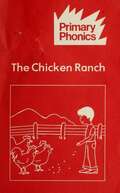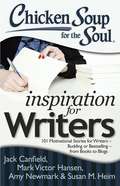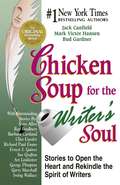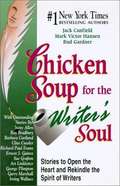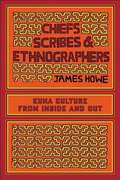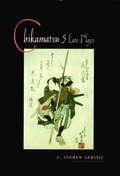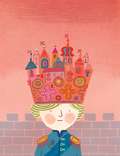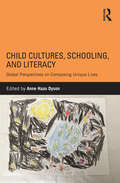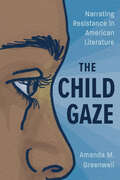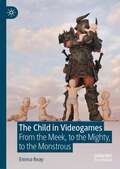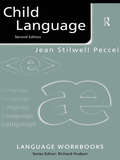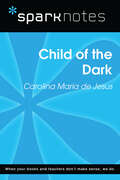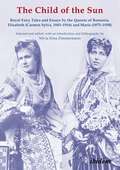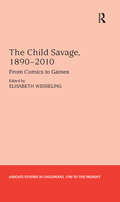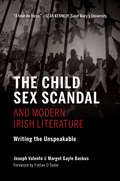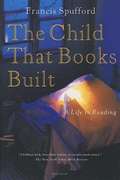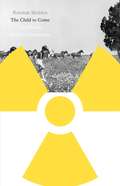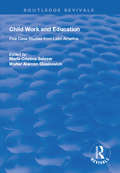- Table View
- List View
Chicka Chicka Ho Ho Ho (Chicka Chicka Book, A)
by William Boniface<b>A New York Times Bestseller</b> <p> In a much-anticipated new companion to the beloved and bestselling classic Chicka Chicka Boom Boom, the rollicking alphabet chant gets a holiday twist. A told B, and B told C, “I’ll meet you in the branches of the Christmas tree.” In this holiday alphabet rhyme, the crew of beloved letters gets their chance to shine as decorations on the Christmas tree!
The Chicken Ranch (Primary Phonics #Set 4 Book 2)
by Barbara W. MakarA systematic, phonics-based early reading program that includes: the most practice for every skill, decodable readers for every skill, and reinforcement materials--help struggling students succeed in the regular classroom
Chicken Soup for the Soul: Inspiration for Writers
by Amy Newmark Mark Victor Hansen Jack Canfield Susan M. HeimWith 101 stories from published writers who stuck with it and succeeded, you will be inspired and encouraged, whether you're an aspiring author, a blogger, or a bestselling writer.No matter the genre, no matter the medium, the writing process is hard! But you will find inspiration, encouragement, and advice in these 101 stories from others who have stuck with it, through the setbacks and struggles, and successfully went from dreaming about writing to being a writer.
Chicken Soup for the Writer's Soul: Stories to Open the Heart and Rekindle the Spirit of Writers
by Jack Canfield Mark Victor Hansen Bud GardnerBeing a writer can be a lonely and frustrating experience. The stories in this book--by a wide range of professional writers, novelists, journalists, freelancers, poets, and screenwriters--will give readers insight into the human trials, tribulations, and triumphs of writers, and writers a source of inspiration and commiseration. Whether readers are beginning writers, seasoned pros, or wannabes, the stories of purpose, passion, endurance, and success contained in Chicken Soup for the Writer's Soul will inform, entertain, uplift, and inspire them. In its pages, they will learn important lessons on: the importance of perseverance, the value of being yourself, the process of discovering your own voice, the need for mentors and allies, and the power of following your heartfelt dreams. Contributors include: Sue Grafton, Steve Allen, Dave Barry, Agatha Christie, Art Linkletter, Terry McMillan, and more.
Chicken Soup for the Writer's Soul: Stories to Open the Heart and Rekindle the Spirit of Writers
by Jack Canfield Mark Victor Hansen Bud GardnerThis is a collection of essays by familiar and unfamiliar writers of stage plays, screen plays, sport columns, short stories, comedy routines, newspaper and magazine articles, cartoons and novels, from romance to adventure, to detective. They open their hearts to would be writers covering the spectrum of the writing experience. from its lowest ebb to the apex of its successes. You will read about writers low on money and high on rejection slips. Some of the record breaking best selling writers of all time describe their bulging file folders of hundreds of rejection letters. As you read their essays you'll feel as if you met them, spent quality, one on one time with them. Discover how a mother writes romance with a houseful of bickering kids vying for attention, how a sports writer risks his life and breaks his limbs to participate in the sports he writes about first hand. Walk beside untried writer hopefuls who meet their author heroes like the genuinely warm and generous Alex Haley and the outspoken, brilliant Sinclair Lewis. You'll see that success is often built on failure as was the experience of the author of Sleepless in Seattle, whose first play was viciously attacked by critics and closed after one performance. Ray Bradbury writes a beautifully poetic ode to the joy of lifelong reading declaring that you must read what you like, not what you are told to or expected to read. He promises that what you read contributes to who you will become. Sue Grafton confides that she is living her father's dream as well as her own. He taught her the groundwork for becoming a successful author while denying himself that dream. Whether you sample the articles that call to you, or read this wonderful collection of heartfelt, first hand experiences with the writing process, you will learn, be amused and moved and deeply enjoy and appreciate every word, every page, every meeting with every author. Cartoons are included and described.
Chicken Soup for the Writer's Soul
by Bud Gardner Mark Victor Hansen Jack CanfieldBeing a writer can be a lonely and frustrating experience. The stories in this book--by a wide range of professional writers, novelists, journalists, freelancers, poets, and screenwriters--will give readers insight into the human trials, tribulations, and triumphs of writers, and writers a source of inspiration and commiseration. Whether readers are beginning writers, seasoned pros, or wannabes, the stories of purpose, passion, endurance, and success contained in Chicken Soup for the Writer's Soul will inform, entertain, uplift, and inspire them. In its pages, they will learn important lessons on: the importance of perseverance, the value of being yourself, the process of discovering your own voice, the need for mentors and allies, and the power of following your heartfelt dreams. Contributors include: Sue Grafton, Steve Allen, Dave Barry, Agatha Christie, Art Linkletter, Terry McMillan, and more.
Chicken Soup with Rice: A Book of Months
by Maurice Sendak"In August it will be so hot I will become a cooking pot cooking soup of course. Why not? Cooking once cooking twice cooking chicken soup with rice. ..."
The Chicktionary
by Anna LeflerYou're all over the definitions of "low lights," "ruching," and a "tankini." But can you spot a "Mrs. Potato Head" when you see one? That's where The Chicktionary comes in. With the help of Anna Lefler and her collection of 450+ must-know words and phrases, you'll be in the know when faced with terms like Aberzombie, Bandeau, George Glass, and Puma. So whether you are dealing with a Residual Girlfriend, diagnose yourself with a bad case of Basset Knees, or need to go on a Briet, you'll be prepared for all that comes your way. At the very least, this book will serve as a delightful reminder that everyone has a skeleton in her closet--right next to her fat pants.
The Chicktionary
by Anna LeflerYou're all over the definitions of "low lights," "ruching," and a "tankini. " But can you spot a "Mrs. Potato Head" when you see one? That's whereThe Chicktionarycomes in. With the help of Anna Lefler and her collection of 450+ must-know words and phrases, you'll be in the know when faced with terms likeAberzombie,Bandeau,George Glass, andPuma. So whether you are dealing with aResidual Girlfriend, diagnose yourself with a bad case ofBasset Knees, or need to go on aBriet, you'll be prepared for all that comes your way. At the very least, this book will serve as a delightful reminder that everyone has a skeleton in her closet--right next to her fat pants.
Chiefs, Scribes, and Ethnographers
by James HoweThe Kuna of Panama, today one of the best known indigenous peoples of Latin America, moved over the course of the twentieth century from orality and isolation towards literacy and an active engagement with the nation and the world. Recognizing the fascination their culture has held for many outsiders, Kuna intellectuals and villagers have collaborated actively with foreign anthropologists to counter anti-Indian prejudice with positive accounts of their people, thus becoming the agents as well as subjects of ethnography. One team of chiefs and secretaries, in particular, independently produced a series of historical and cultural texts, later published in Sweden, that today still constitute the foundation of Kuna ethnography. As a study of the political uses of literacy, of western representation and indigenous counter-representation, and of the ambivalent inter-cultural dialogue at the heart of ethnography, Chiefs, Scribes, and Ethnographers addresses key issues in contemporary anthropology. It is the story of an extended ethnographic encounter, one involving hundreds of active participants on both sides and continuing today.
Chikamatsu: Five Late Plays (Translations from the Asian Classics #No. 116)
by ChikamatsuChikamatsu Monzaemon (1653-1725), often referred to as "Japan's Shakespeare" and a "god of writers," was arguably the most famous playwright in Japanese history and wrote more than 100 plays for the kabuki and bunraku theaters. Today, the plays of this major literary figure are performed on kabuki and bunraku stages as well as in the modern theater, and forty-nine films of his plays have been made, thirty-one of them from the silent era.Translations of Chikamatsu's plays are available, but we have few examples of his late work, in which he increasingly incorporated stylistic elements of his shorter, contemporary dramas into his longer period pieces. Translator C. Andrew Gerstle argues that in these mature history plays, Chikamatsu depicted the tension between the private and public spheres of society by combining the rich character development of his contemporary pieces with the larger political themes of his period pieces. In this volume Gerstle translates five plays—four histories and one contemporary piece—never before available in English that complement other collections of Chikamatsu's work, revealing new dimensions to the work of this great Japanese playwright and artist.
Child Autonomy and Child Governance in Children's Literature: Where Children Rule (Children's Literature and Culture)
by Christopher Kelen Bjorn SundmarkThis book explores representations of child autonomy and self-governance in children’s literature.The idea of child rule and child realms is central to children’s literature, and childhood is frequently represented as a state of being, with children seen as aliens in need of passports to Adultland (and vice versa). In a sense all children’s literature depends on the idea that children are different, separate, and in command of their own imaginative spaces and places. Although the idea of child rule is a persistent theme in discussions of children’s literature (or about children and childhood) the metaphor itself has never been properly unpacked with critical reference to examples from those many texts that are contingent on the authority and/or power of children. Child governance and autonomy can be seen as natural or perverse; it can be displayed as a threat or as a promise. Accordingly, the "child rule"-motif can be seen in Robinsonades and horror films, in philosophical treatises and in series fiction. The representations of self-ruling children are manifold and ambivalent, and range from the idyllic to the nightmarish. Contributors to this volume visit a range of texts in which children are, in various ways, empowered, discussing whether childhood itself may be thought of as a nationality, and what that may imply. This collection shows how representations of child governance have been used for different ideological, aesthetic, and pedagogical reasons, and will appeal to scholars of children’s literature, childhood studies, and cultural studies.
Child Cultures, Schooling, and Literacy: Global Perspectives on Composing Unique Lives
by Anne Haas DysonThrough analysis of case studies of young children (ages 3 to 8 years), situated in different geographic, cultural, linguistic, political, and socioeconomic sites on six continents, this book examines the interplay of childhoods, schooling, and, literacies. Written language is situated within particular childhoods as they unfold in school. A key focus is on children’s agency in the construction of their own childhoods. The book generates diverse perspectives on what written language may mean for childhoods. Looking at variations in the complex relationships between official (curricular) visions and unofficial (child-initiated) visions of relevant composing practices and appropriate cultural resources, it offers, first, insight into how those relationships may change over time and space as children move through early schooling, and, second, understanding of the dynamics of schools and the experience of childhoods through which the local meaning of school literacy is formulated. Each case—each child in a particular sociocultural site—does not represent an essentialized nation or a people but, rather, a rich, processual depiction of childhood being constructed in particular local contexts and the role, if any, for composing.
The Child Gaze: Narrating Resistance in American Literature (Children's Literature Association Series)
by Amanda M. GreenwellThe Child Gaze: Narrating Resistance in American Literature theorizes the child gaze as a narrative strategy for social critique in twentieth- and twenty-first-century US literature for children and adults. Through a range of texts, including James Baldwin’s Little Man, Little Man, Mildred D. Taylor’s Roll of Thunder, Hear My Cry, Toni Morrison’s The Bluest Eye, Gene Luen Yang’s American Born Chinese, and more, Amanda M. Greenwell focuses on children and their literal acts of looking. Detailing how these acts of looking direct the reader, she posits that the sightlines of children serve as signals to renegotiate hegemonic ideologies of race, ethnicity, creed, class, and gender. In her analysis, Greenwell shows how acts of looking constitute a flexible and effective narrative strategy, capable of operating across multiple points of view, focalizations, audiences, and forms. Weaving together scholarship on the US child, visual culture studies, narrative theory, and other critical traditions, The Child Gaze explores the ways in which child acts of looking compel readers to look at and with a child character, whose gaze encourages critiques of privileged visions of national identity. Chapters investigate how child acts of looking allow texts to redraw circles of inclusion around the locus of the child gaze and mobilize childhood as a site of resistance. The powerful child gaze can thus disrupt dominant scripts of power, widening the lens through which belonging in the US can be understood.
The Child in British Literature
by Adrienne E. GavinThe first volume to consider childhood over eight centuries of British writing, this book traces the literary child from medieval to contemporary texts. Written by international experts, the volume's essays challenge earlier readings of childhood and offer fascinating contributions to the current upsurge of interest in constructions of childhood.
The Child in Videogames: From the Meek, to the Mighty, to the Monstrous
by Emma ReayDrawing across Games Studies, Childhood Studies, and Children’s Literature Studies, this book redirects critical conversations away from questions of whether videogames are ‘good’ or ‘bad’ for child-players and towards questions of how videogames produce childhood as a set of social roles and rules in contemporary Western contexts. It does so by cataloguing and critiquing representations of childhood across a corpus of over 500 contemporary videogames. While child-players are frequently the topic of academic debate – particularly within the fields of psychology, behavioural science, and education research - child-characters in videogames are all but invisible. This book's aim is to make these child-characters not only visible, but legible, and to demonstrate that coded kids in virtual worlds can shed light on how and why the boundaries between adults and children are shifting.
Child Language
by Jean Stilwell PecceiBuilding on the established strengths of the first edition, Child Language has now been fully updated and includes some basic theory content, more exercises and summaries at the end of each unit. Child Language:* introduces students to key areas involved in the study of children's language: vocabulary development, word and sentence structure, conversational skills and pronunciation* contains a corpus of children's language* includes suggestions for project work.
Child of the Dark (SparkNotes Literature Guide Series)
by SparkNotesChild of the Dark (SparkNotes Literature Guide) by Carolina Maria de Jesus Making the reading experience fun! Created by Harvard students for students everywhere, SparkNotes is a new breed of study guide: smarter, better, faster.Geared to what today's students need to know, SparkNotes provides:chapter-by-chapter analysis explanations of key themes, motifs, and symbols a review quiz and essay topicsLively and accessible, these guides are perfect for late-night studying and writing papers.
The Child of the Sun: Royal Fairy Tales and Essays by the Queens of Romania, Elisabeth (Carmen Sylva, 1843–1916) and Marie (1875–1938) (Series of the Research Center Carmen Sylva Fürstlich Wiedisches Archive #9)
by Silvia Irina ZimmermannThe history of the monarchy in Romania and of its four kings would be incomplete without the story of the queen consorts, who seem to have been even more fascinating personalities than the kings were. Especially the first two queen consorts, Elisabeth (Carmen Sylva) and Marie of Romania, became famous as writers during their lifetime. They both wrote in their mother tongues, Elisabeth in German and Marie in English, and published many of their books, not only in Romania, but also abroad, thus reaching a widespread readership, worldwide publicity, and literary recognition.This affectionately collected, critically edited volume comprises the most precious tales and essays by the queen consorts, either translated into English (Carmen Sylva) or in the original English version (Marie of Romania).
The Child Savage, 1890–2010: From Comics to Games (Studies in Childhood, 1700 to the Present)
by Elisabeth WesselingTaking up the understudied relationship between the cultural history of childhood and media studies, this volume traces twentieth-century migrations of the child-savage analogy from colonial into postcolonial discourse across a wide range of old and new media. Older and newer media such as films, textbooks, children's literature, periodicals, comic strips, children's radio, and toys are deeply implicated in each other through ongoing 'remediation', meaning that they continually mimic, absorb and transform each other's representational formats, stylistic features, and content. Media theory thus confronts the cultural history of childhood with the challenge of re-thinking change in childhood imaginaries as transformation-through-repetition patterns, rather than as rise-shine-decline sequences. This volume takes up this challenge, demonstrating that one historical epoch may well accommodate diverging childhood repertoires, which are recycled again and again as they are played out across a whole gamut of different media formats in the course of time.
The Child Sex Scandal and Modern Irish Literature: Writing the Unspeakable (Irish Culture, Memory, Place)
by Joseph Valente Margot Gayle BackusEven though the Irish child sex abuse scandals in the Catholic Church have appeared steadily in the media, many children remain in peril. In The Child Sex Scandal and Modern Irish Literature, Joseph Valente and Margot Gayle Backus examine modern cultural responses to child sex abuse in Ireland. Using descriptions of these scandals found in newspapers, historiographical analysis, and 20th- and 21st-century literature, Valente and Backus expose a public sphere ardently committed to Irish children's souls and piously oblivious to their physical welfare. They offer historically contextualized and psychoanalytically informed readings of scandal narratives by nine notable modern Irish authors who actively, pointedly, and persistently question Ireland's responsibilities regarding its children. Through close, critical readings, a more nuanced and troubling account emerges of how Ireland's postcolonial heritage has served to enable such abuse. The Child Sex Scandal and Modern Irish Literature refines the debates on why so many Irish children were lost by offering insight into the lived experience of both the children and those who failed them.
The Child That Books Built: A Life in Reading
by Francis SpuffordIn this extended love letter to children's books and the wonders they perform, Francis Spufford makes a confession: books were his mother, his father, his school. Reading made him who he is. To understand the thrall of fiction, Spufford goes back to his earliest encounters with books, exploring such beloved classics as The Wind in the Willows, The Little House on the Prairie, and The Chronicles of Narnia. He recreates the excitement of discovery, writing joyfully of the moment when fuzzy marks on a page become words. Weaving together child development, personal reflection, and social observation, Spufford shows the force of fiction in shaping a child: how stories allow for escape from pain and mastery of the world, how they shift our boundaries of the sayable, how they stretch the chambers of our imagination.
The Child to Come: Life after the Human Catastrophe
by Rebekah SheldonGeneration Anthropocene. Storms of My Grandchildren. Our Children&’s Trust. Why do these and other attempts to imagine the planet&’s uncertain future return us—again and again—to the image of the child? In The Child to Come, Rebekah Sheldon demonstrates the pervasive conjunction of the imperiled child and the threatened Earth and blisteringly critiques the logic of catastrophe that serves as its motive and its method. Sheldon explores representations of this perilous future and the new figurations of the child that have arisen in response to it. Analyzing catastrophe discourse from the 1960s to the present—books by Joanna Russ, Margaret Atwood, and Cormac McCarthy; films and television series including Southland Tales, Battlestar Galactica, and Children of Men; and popular environmentalism—Sheldon finds the child standing in the place of the human species, coordinating its safe passage into the future through the promise of one more generation. Yet, she contends, the child figure emerges bound to the very forces of nonhuman vitality he was forged to contain. Bringing together queer theory, ecocriticism, and science studies, The Child to Come draws on and extends arguments in childhood studies about the interweaving of the child with the life sciences. Sheldon reveals that neither life nor the child are what they used to be. Under pressure from ecological change, artificial reproductive technology, genetic engineering, and the neoliberalization of the economy, the queerly human child signals something new: the biopolitics of reproduction. By promising the pliability of the body&’s vitality, the pregnant woman and the sacred child have become the paradigmatic figures for twenty-first century biopolitics.
Child Work and Education: Five Case Studies from Latin America (Routledge Revivals)
by María Cristina Salazar Walter Alarcón GlasinovichPublished in 1998. In recent years research, as well as the results of practical programmes, has led to a clearer understanding of the relationship between child work and education. It is increasingly evident that child work is not entirely the result of economic need or exploitation. Frequently is the failure of educational system to offer adequate, stimulating and affordable schooling that encourages children to drop out in favour of work that appears to offer advantages more relevant to their everyday lives. Parents too may undervalue the role and purpose of a school that provides inadequate preparation for the future and often see a job, including home-based work, as a positive alternative to crime, delinquency or begging. Consequently, while a distinction needs to be made between ‘formative child work’ and ‘harmful child work’, in certain situations and cultures the phenomenon is not always seen as negative. Yet, although gratifying in the short term and sometimes even providing the means for a younger child to attend school as well as a way of learning discipline and responsibility, often these jobs provide no useful experience and do not lead to an improvement in the personal development of life chances of a child. The situation is therefore complex and requires a more realistic evolution of the relationship between archaic pedagogy, dropout rates and child work. These five case studies from Latin America all reveal the effects of inappropriate school curricular. Desertion of the educational system for the labour market leads to inadequate training and perpetuates the poverty trap. As part of the commitment to combating work which is detrimental to the child, major educational reform is needed. Improvements in coverage, quality and affordability should lead to greater acceptance pf schooling at all levels of society and provide a greater incentive for parents and children alike to participate more fully in the system. Moreover, in cases of severe economic hardship and forced or harmful labour, practical assistance with subsides and scholarships should be considered to remove children from such work.

